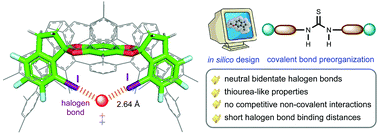Themed collection Halogen bonding in organic synthesis and catalysis

Halogen bond-induced electrophilic aromatic halogenations
This review highlights the recent development of halogen bond-induced activations of N-halosuccinimides and N,N-dihalodimethylhydantoins in electrophilic aromatic halogenations.

Org. Biomol. Chem., 2021,19, 7518-7534
https://doi.org/10.1039/D1OB00936B
Halogen bonding effect on electrochemical anion oxidation in ionic liquids
The properties of three imidazolium based ionic liquids have been compared and used as solvents for the electrochemical oxidation of various anions.

Org. Biomol. Chem., 2021,19, 7587-7593
https://doi.org/10.1039/D1OB01031J
Enantio- and diastereoselective double Mannich reaction of malononitrile with N-Boc imines using quinine-derived bifunctional organoiodine catalyst
A chiral organic base catalyst with halogen bond donor functionality was used to promote the asymmetric double Mannich reaction to afford 1,3-diamines in excellent yields with high enantio- and diastereoselectivities.

Org. Biomol. Chem., 2021,19, 6969-6973
https://doi.org/10.1039/D1OB00796C
A bench-stable N-trifluoroacetyl nitrene equivalent for a simple synthesis of 2-trifluoromethyl oxazoles
ortho-Nitro-substituted N-trifluoroacetyl imino-λ3-iodane is a bench-stable trifluoroacetyl nitrene precursor, in which intra- and intermolecular halogen bonding (XB) plays an important role.

Org. Biomol. Chem., 2021,19, 6628-6632
https://doi.org/10.1039/D1OB00947H
Mukaiyama aldol reaction catalyzed by (benz)imidazolium-based halogen bond donors
A Mukaiyama aldol reaction can be catalyzed by bidentate halogen bond donors with very high efficiency. The halogenated catalysts were stable over multiple consecutive runs, which supports the halogen-bond-based mode of catalysis.

Org. Biomol. Chem., 2021,19, 770-774
https://doi.org/10.1039/D0OB02503H
Are bis(pyridine)iodine(I) complexes applicable for asymmetric halogenation?
The enantioselectivity of the iodine(I) transfer process from chiral bis(pyridine)iodine(I) complexes to alkenes is explored.

Org. Biomol. Chem., 2021,19, 8307-8323
https://doi.org/10.1039/D1OB01532J
In silico characterization and prediction of thiourea-like neutral bidentate halogen bond catalysts
Through DFT calculations, thiourea-like halogen bond (XB)-based catalysts, with XB donor moieties connected via covalent bonds, have been designed and applied to Diels–Alder reaction and sulfa-Michael addition.

Org. Biomol. Chem., 2021,19, 7051-7060
https://doi.org/10.1039/D1OB01092A
Biological halogen bonds in protein–ligand complexes: a combined QTAIM and NCIPlot study in four representative cases
In this study, the PDB has been inspected for the analysis of HaBs in biological systems, highlighting their importance in four different protein–ligand systems.

Org. Biomol. Chem., 2021,19, 6858-6864
https://doi.org/10.1039/D1OB01212F
Intermolecular binding preferences of haloethynyl halogen-bond donors as a function of molecular electrostatic potentials in a family of N-(pyridin-2-yl)amides
The roles played by halogen bonds and hydrogen bonds in the crystal structures of N-(pyridin-2-yl)amides were evaluated and rationalised in the context of calculated molecular electrostatic potentials.

Org. Biomol. Chem., 2021,19, 6671-6681
https://doi.org/10.1039/D1OB01133B
About this collection
- Studies involving halogen bonding applications in organic synthesis and catalysis
- Theoretical contributions on halogen bonding relevant to organic systems
- Halogen bonding in chemical biology and biomolecular chemistry
- Physical organic chemistry of halogen bonding
- molecular design of organic and supramolecular materials involving halogen bonding